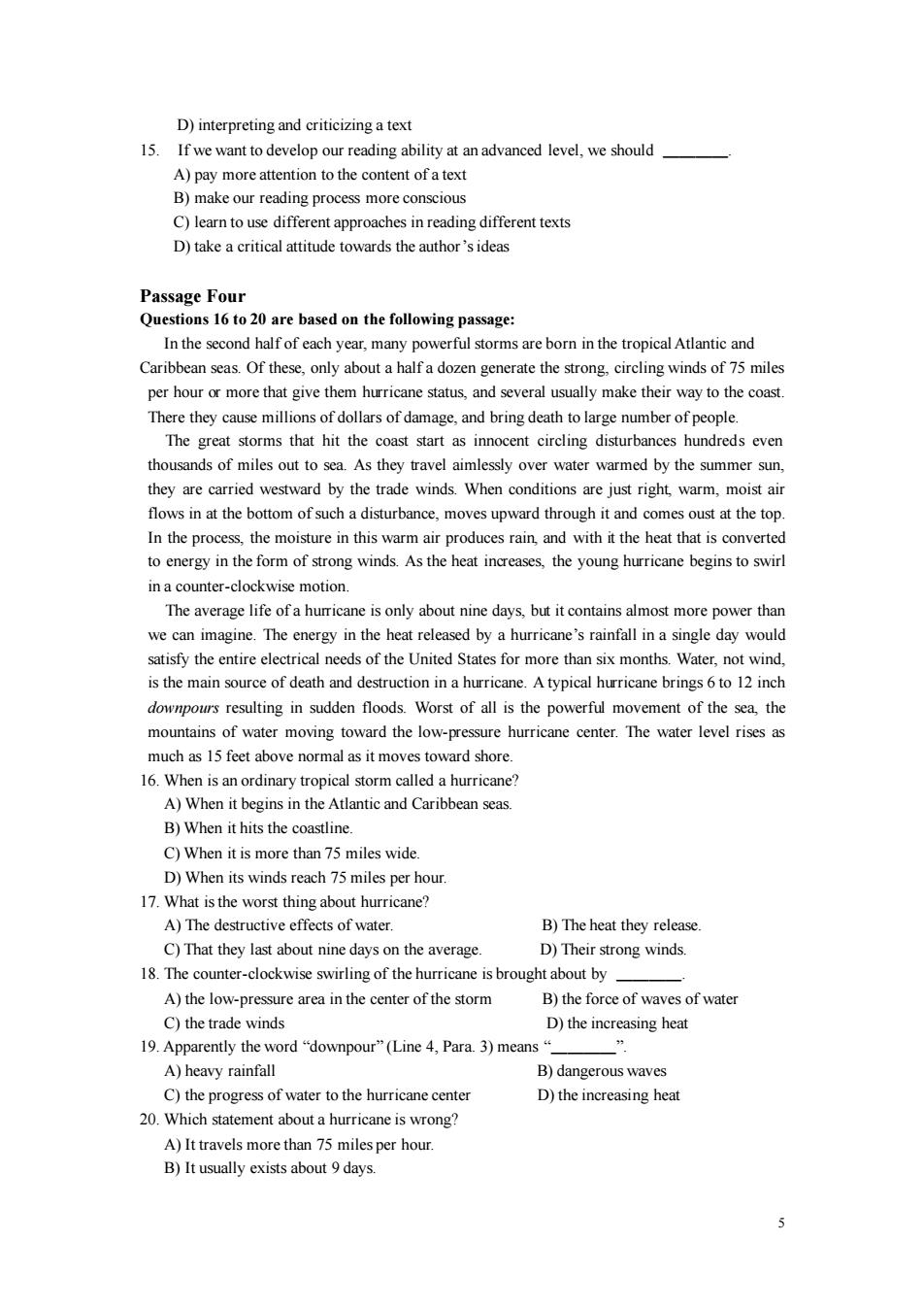正在加载图片...

D)interpreting and criticizing a text 15.If we want to develop our reading ability a an advanced level,we should A)pay more attention to the o fatex B)make our reading process more conscious C)learn to use different approaches in reading different texts D)take a critical attitude towards the author'sideas Passage Four Questions 16 to 20 are based on the following passage: In the second half of each year,many powerful storms are born in the tropical Atlantic and Caribbean seas.Of these,only about a halfa dozen generate the strong.circling winds of 75 miles per hour or more that give them hurricane status.and several usually make their way to the coast t ht theneron rn thousands of miles out to sea.As they travel aimlessly over water warmed by the summer sun they are carried westward by the trade winds.When conditions are just right,warm,moist air flows in at the bottom of such a disturbance,moves upward through it and comes oust at the top ocess,the moisture in this warm air oduces ain and with it the heat that form of strong winds the young eginst in a counter-clockwise motion The average life of a hurricane is only about nine days.but it contains almost more power than we can imagine.The energy in the heat released by a hurricane's rainfall in a single day would satisfy the entire electrical needs of the United States for more than six months.Water,not wind. s the main so rce of deatha d de in a b Atypical hur downpours resulting in sudden floods.Worst of all is the powerful movement of the sea,the mountains of water moving toward the low-pressure hurricane center.The water level rises as much as 15 feet above normal as it moves toward shore. 16.When is an ordinary tropical storm called a hurricane? A)When it begins in the Atlantic and Caribbean seas B)When it hits the coa astline C)When it is more than 75 miles wide D)When its winds reach 75 miles per hour 17.What is the worst thing about hurricane? A)The destructive effects of water B)The heat they release C)That they last a out nine dayson the average D)Their strong winds 8.The counter-oise swirling of the huricane is brought about by A)the low-pressure area in the center of the storm B)the force of waves of water C)the trade winds D)the increasing heat 19.Apparently the word"downpour"(Line 4,Para.3)means A)heavy rainfall B)da waves C)the progress of water to the hurricane cente D)the increasing hea 20.Which statement about a hurricane is wrong? A)It travels more than 75 miles per hour B)It usually exists about 9days 5 D) interpreting and criticizing a text 15. If we want to develop our reading ability at an advanced level, we should ____. A) pay more attention to the content of a text B) make our reading process more conscious C) learn to use different approaches in reading different texts D) take a critical attitude towards the author’s ideas Passage Four Questions 16 to 20 are based on the following passage: In the second half of each year, many powerful storms are born in the tropical Atlantic and Caribbean seas. Of these, only about a half a dozen generate the strong, circling winds of 75 miles per hour or more that give them hurricane status, and several usually make their way to the coast. There they cause millions of dollars of damage, and bring death to large number of people. The great storms that hit the coast start as innocent circling disturbances hundreds even thousands of miles out to sea. As they travel aimlessly over water warmed by the summer sun, they are carried westward by the trade winds. When conditions are just right, warm, moist air flows in at the bottom of such a disturbance, moves upward through it and comes oust at the top. In the process, the moisture in this warm air produces rain, and with it the heat that is converted to energy in the form of strong winds. As the heat increases, the young hurricane begins to swirl in a counter-clockwise motion. The average life of a hurricane is only about nine days, but it contains almost more power than we can imagine. The energy in the heat released by a hurricane’s rainfall in a single day would satisfy the entire electrical needs of the United States for more than six months. Water, not wind, is the main source of death and destruction in a hurricane. A typical hurricane brings 6 to 12 inch downpours resulting in sudden floods. Worst of all is the powerful movement of the sea, the mountains of water moving toward the low-pressure hurricane center. The water level rises as much as 15 feet above normal as it moves toward shore. 16. When is an ordinary tropical storm called a hurricane? A) When it begins in the Atlantic and Caribbean seas. B) When it hits the coastline. C) When it is more than 75 miles wide. D) When its winds reach 75 miles per hour. 17. What is the worst thing about hurricane? A) The destructive effects of water. B) The heat they release. C) That they last about nine days on the average. D) Their strong winds. 18. The counter-clockwise swirling of the hurricane is brought about by ____. A) the low-pressure area in the center of the storm B) the force of waves of water C) the trade winds D) the increasing heat 19. Apparently the word “downpour” (Line 4, Para. 3) means “____”. A) heavy rainfall B) dangerous waves C) the progress of water to the hurricane center D) the increasing heat 20. Which statement about a hurricane is wrong? A) It travels more than 75 miles per hour. B) It usually exists about 9 days